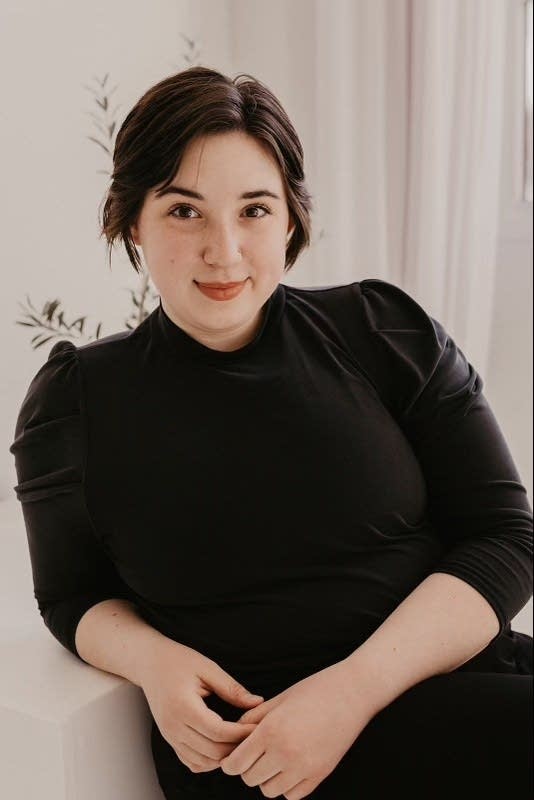Eating disorders remain a hidden struggle in performing arts

Go Deeper.
Create an account or log in to save stories.
Like this?
Thanks for liking this story! We have added it to a list of your favorite stories.
Bridget Benson’s love for performing was born when she discovered the musical “Hairspray.”
“I would play [it] all the time in my CD player,” Benson said, recounting how she would pull out the lyric sleeve from the CD case.
“I would sing Tracy’s part, and my neighbor would sing Penny’s part.”
Now 24, Benson has choreographed and directed youth productions across the Twin Cities metro and has continued to perform. She recently wrapped a production of “A Taste of Things to Come” at Lyric Arts in Anoka.
Turn Up Your Support
MPR News helps you turn down the noise and build shared understanding. Turn up your support for this public resource and keep trusted journalism accessible to all.
While she developed as a young performer, however, Benson engaged in disordered eating behaviors. She noticed she was doing it around the age of 13.
“It wasn’t something that I necessarily really took into account, until I was in college,” Benson said.
She describes reaching a point where she became hyperaware of her body. On a near daily basis, she was thinking about the kinds of foods she was eating.
“They way I was living was incredibly unhealthy and I didn’t know how to control it, I felt very helpless.”
Eventually, with encouragement from family and friends, she sought out treatment for her binge eating disorder at the Emily Program, a national organization based and founded in Minnesota.

“Eating disorders impact people of all ages, all genders, all races, all ethnicities, all walks of life,” said Jillian Lampert, an executive with the Emily Program and eating disorder expert. She points out there’s a common belief that eating disorders only affect thin women.
“It leads people who experience these illnesses, if they don’t meet those sorts of societal constructs of what people imagine somebody with an eating disorder looks like, they don’t know that they can get treatment.”
In 2025, the Emily Program is committing to highlight the diversity of people affected by eating disorders — specifically by including more men and boys in their marketing. At the Emily Program, treatment can include personalized therapy, nutritional guidance and support groups. These groups are not separated by gender, age or career.
“The experience of having an eating disorder is quite common,” Lampert said.
“We have clients who sit in a room and there’s a whole group of different folks in a room, but they’re so united by some of the same thoughts and feelings and behaviors they have, and they can find such amazing support in each other.”
While the experience can be common, different factors can influence why people develop eating disorders. For entertainers and athletes, the drive to maintain a certain physical look can add pressure and contribute to eating disorder behaviors. Singers including Paula Abdul and Ed Sheeran have openly discussed their struggles, and how the industry impacted their self-image.
“They’re so visible that if part of your livelihood is people looking at you, then the pressure to look a certain way is pretty intense,” Lampert said.

Perception plays a major role in the overall mentality of performers, says Michelle Sherman, a clinical psychologist who has served as a behavioral health consultant for many theater productions in Minnesota.
“If you think of the performers, they are continuously, by definition, putting themselves, their body in auditions, on stage, repeatedly to be evaluated and judged,” Sherman said, adding that the body can’t always tell acting from reality.
“Even though you’re in a role, you are being seen as presenting yourself.”
Benson recognizes the industry’s stress on looking a particular way for a role. However, she also recognizes that the idea that only certain body types can play certain roles is outdated.
“We are still holding on to specific ideals of body types, sometimes even to the point of specific character types equating to body types,” Benson said.
“Anybody is perfectly capable of being an excellent performer in dance, in plays and musicals or other various forms of storytelling”
Benson wants the industry to continue examining how it props up these ideas, and to take risks to change things.
“These things are going to be the way that they’ve always been, until someone makes a change, until someone decides to do something differently.”
This story is part of Call to Mind, American Public Media and MPR’s initiative to foster new conversations about mental health.
Dear reader,
Your voice matters. And we want to hear it.
Will you help shape the future of Minnesota Public Radio by taking our short Listener Survey?
It only takes a few minutes, and your input helps us serve you better—whether it’s news, culture, or the conversations that matter most to Minnesotans.




